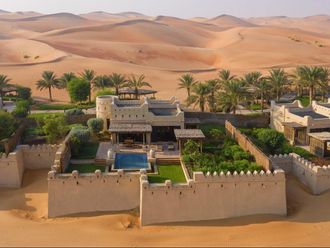
Flowers mostly aren’t real food — unless you are a cow, of course. In France, among the rolling hills of Midi-Pyrénées where wild flowers abound, the herbivores have it good; for violets, lavenders and dandelions present a colourful salad. But now edible flowers cultivated in France or England are also making it to adventuresome human menus. And for those who like to look at their food as much as eat it, edible flowers are essential.
“Edible flowers are like white gold; the fashion comes and goes. They were very fashionable in the eighties. Then they disappeared and went off menus. Now they are reappearing and they go very well with simple food items such as grilled fish or salad,” says Charles Boghos of Chez Charles, an online exotic food shop that caters to the UAE’s enthusiastic home chefs.
It is fashionable to eat flowers. Sometimes it’s only a matter of taking the time to taste some — for example, when walking around Safa Park’s tree-lined pathways, stop to pick some orangey-red petals of royal poinciana or gulmohar off the grass and savour their mild tanginess.
At eattheweeds.com, a website dedicated to wild foods, there’s a forum for finding the tastiest flowers of them all. Oxeye daisy, phlox and begonias make an appearance, as do crispy, succulent, refreshing and slightly sweet yucca blossoms.
User Henriette dishes out a recipe of dandelion flowers in an omelette: “Melt butter in a hot pan, cover it with dandelion flowers face down, sprinkle a bit of lemon juice, add the usual omelette batter, lower the heat, put a lid on, let it sit for 15 minutes and it’s ready to eat.”
However, not all flowers are edible. Some are actually poisonous. One experimenter speaks of having tried and set limits with crispy day lilies of which you can eat only one raw blossom — any more and your stomach is likely to do double and triple flips.
“Let people not venture into flower shops for lunch. Edible flowers cannot be grown on soil with chemicals,” cautions Boghos.
Apart from impromptu snacking by the roadside, flowers have long been sprinkled as garnish — early Romans favoured salads with marigolds. We come across candied rose petals in many Middle Eastern delicacies. Boghos says his customers use boxes of edible flowers to garnish green and grain salads and spruce up appetiser trays. They are used in cocktails or frozen with water to make pretty ice cubes. Interchangeably used, they taste like variations of grass.
Those who really love flora don’t just pay lip service to the concept of gourmet flowers. Dandelion fritters, tuberous begonia petals in citrus dip, lavender ice cream, rose jam, camomille lamb chops with lemon, crystallised violets, pickled sunflower buds, lilac sorbet and candied pansies with mint leaves are testimony to their efforts.
For those who take their flowers seriously, the cranberry-like flavour of hibiscus is different from the citrusy tones of the marigold or the wintergreen that comes through a viola tricolour. Roses, of course, have a distinct flavour depending on how strong the fragrance is.
Last year, EAT had reviewed a hibiscus flower crème brûlée with rose petal clouds and mint jelly at Blue Flame, Jumeirah Creekside in Dubai. On Valentine’s Day Cavalli Club at the Fairmont, Dubai created an entire floral menu, which featured delights such as a calendula and saffron risotto served with petals and stamens, slow-poached Scottish salmon with borage and chives, venison with blackberry and lavender jus and a red rose and blue violet panna cotta. Restaurants in the UAE pick and choose the blooms they want on their menus.
“Yes, I definitely use them. In our kitchen, you may find an interesting mix of capers, chives, jasmine, camomille, violets and roses. Capers are cured flower buds, used a lot in Mediterranean cuisine. The aromatic lavender is very nice on breads and pastry preparations and lavender macaroons are just lovely,” says David Contreras, Executive Chef, The Westin Abu Dhabi Golf Resort & Spa.
Come Eid and roses will make an appearance. In the form of powder, rose water, rosebuds or petals, this flower often adds a fragrant swish to food. And as an ingredient in spice blend ras el hanout, edible roses are available in groceries and supermarkets specialising in regional foodstuff.
Lamia Ahmed Al Hashly, owner of Abu Dhabi-based Blossom Sweets, says, “Rose water is essential. You will find it in every kitchen in the Middle East. Baklava, one of our most popular desserts, uses rose water. In the Arabian ice cream bouzat haleeb, rose water is a key ingredient.”
During Ramadan, she adds, people crave Middle Eastern desserts. “We will add a rose cupcake, which will consist of dried rose petals and will be decorated with rose buds. We already have rose eclairs infused with rose water and sprinkled with dried roses on our menu. Our rose mahalabia has rose water and is sprinkled with dried rose petals,” says Al Hashly.







